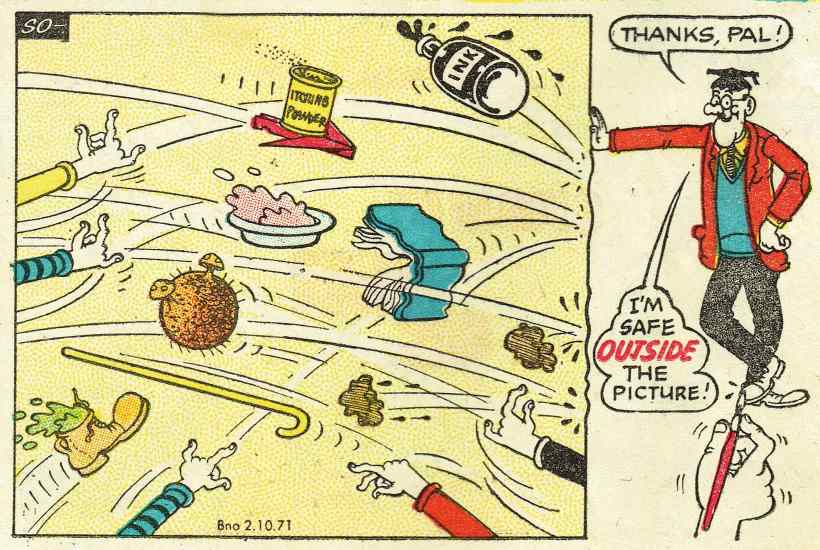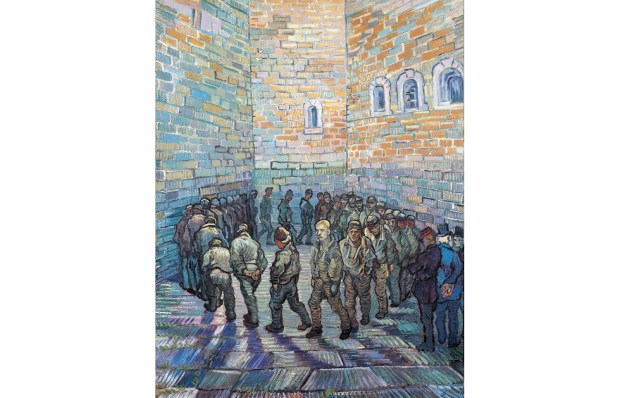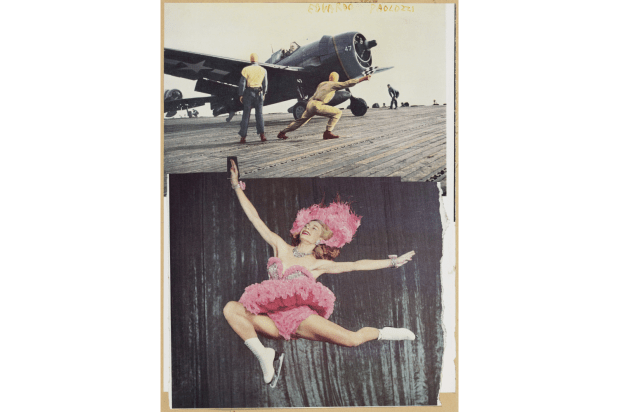Superman and the Beano are both 83 years old. The American superhero first pulled on his tights for Action Comics No. 1 in June 1938. The following month, roughly 443,000 copies were sold of the Beano’s first issue, featuring Pansy Potter (the Strongman’s Daughter), Big Fat Joe, Wee Peem (He’s a Proper Scream) and, my personal role model, Lord Snooty. Not until Grand Theft Auto launched in 1997 has anything so culturally significant come out of Dundee.
But there is a key difference between Supermanand the Beano. While American heroes in general and Superman in particular uphold rules, the Beano’s success — its 4,000th edition in 2019 made it the world’s longest-running weekly comic — is predicated on characters who break them. True, Beano characters do sometimes battle evil (during the second world war, Pansy Potter did her bit for Blighty by single-handedly capturing a Nazi U-boat), but regulars like Ivy the Terrible, Minnie the Minx, Dennis the Menace, Roger the Doger and the Bash Street Kids were and are antinomian scamps bent on wreaking havoc in a rule-bound world run by grown-ups.
Hence the title of an exhibition Andy Holden is curating at Somerset House in London called The Beano: The Art of Breaking the Rules, in which new works inspired by the comic sit side by side with displays of its best comic strips. Holden, 39, started reading the Beanowhen he moved from primary to secondary school, a rite of passage fraught with intimations of adult responsibility. ‘Beano appears at the time in your life when you are just becoming aware of the rules that will increasingly govern your life, rules that it appears that adults have just made up,’ he says. ‘It is a space of pure escape from the arbitrary nature of the rules of bedtime, school and quantities of ice cream. The characters seemed to say to you, “You may not belong in the adult world, but you are welcome here with us”.’
That said, Holden remembers Walter, the weedy, effeminate, flower-loving nemesis of Dennis the Menace, and how the latter bullied him. ‘When I took watercolour classes,’ he recalls, ‘I kept it secret because I didn’t want to be thought of as Walter.’ But Walter has since been re-imagined: instead of a prissy aesthete, he has become a boastful rich kid who weekly deserves his comeuppance.
Dennis too has changed in lockstep with changing mores: his bottom these days is rarely sore since corporal punishment is frowned upon and so he cannot be given his weekly slippering. Politically incorrect characters have been terminated. Little Plum (Your Redskin Chum), who was born in 1953 along with his pals from the Smelleyfeet tribe Hole-in-um-Head, Little Peach, Chiefy and Pimple, not to mention Treaclefoot the Horse, were all cancelled in 2007. Big Fat Joe is no more, possibly because a poster boy for the morbidly obese is not what Britain needs right now. Baby-Face Finlayson, Les Pretend and Biffo the Bear are other casualties. The suggestively named Cocky Dick (He’s Smart and Slick) didn’t make it into the new millennium. And as for Musso the Wop, a cartoon version of Benito Mussolini, he existed only from 1940 to 1942.
But it’s not only the Beano that changes with the times. Next month will see a comic book featuring the new bisexual Superman Jon Kent (Clark’s son) sharing a kiss with his male friend Jay Nakamura.
One of the Beano’s biggest changes came in 2007 when it employed its first female artist. ‘Now there are three of us,’ says Laura Howell. ‘I don’t know why it took so long but there wasn’t a policy of keeping women artists out as there was at Disney.’ Howell thinks that the Beano’s girls are refreshing, given how female cartoon characters are often rule makers rather than breakers. ‘In The Simpsons, Marge and Lisa are sensible, while Homer and Bart have all the fun by breaking rules. Beano isn’t like that and hasn’t been for decades. When Leo Baxendale created Minnie the Minx as a rebel, he said she was an Amazon warrior in the form of a 12-year-old girl.’
Beano characters frequently have one defining trait: Billy Whizz runs fast, Plug from the Bash Street Kids is no looker, Keyhole Kate snoops and Calamity James is the unluckiest boy in the world. But these far from fully rounded characters meant a great deal to the Beano’s infant demographic. In 1969, the novelist Alex Wheatle was six and living in a children’s home. He found a discarded copy of the Beano, took it to bed and read it under the covers, breaking the rules as he did: ‘I gorged on it until 9 p.m. which was really dangerous for me because you were meant to be asleep by eight. I would close my eyes and imagine what it would be like to interact with these characters. It was a solace.’
But why did the Beano resonate for the British novelist whose tough childhood was recently depicted in one of Steve McQueen’s Small Axe films? ‘Any kid I knew wanted to test boundaries. Beano gave us ideas about what we could get away with.’ His new novel, The Humiliations of Welton Blake, is about a boy who sells insults, a character Wheatle admits was inspired by the Beano’s Rodger the Dodger who has a thick book of dodges to help him and his mates elude adults’ boring tasks.
Holden reckons that the Beano’s influence on post-war British creativity is huge but largely unconscious. ‘Very few artists cite it. The exception is David Bowie, who noted it in his list of great works of literature.’ That certainly explains Bowie’s Laughing Gnome and, perhaps, even his later androgynous personae.
Indeed, Holden thinks the Beano has a secret history of influencing generations of British artists. He once found himself in Trafalgar Square looking at Heather Phillipson’s oversized ice cream cornet surmounting the Fourth Plinth and thought its infantile theme of gluttony and excess indicated she read the Beano as a kid. ‘I rang her up and she admitted it.’
But don’t artists set aside such childish things when they grow up? Holden suggests not: ‘Although you gradually slip out of Beanotown at an unremembered point long in the past, you also never really do, you carry its spirit of restless motion-marks with you, and if you are lucky, use it to reinterpret a few rules of your own.’ As for Laura Howell, she worked in her twenties in children’s publishing before realising that what she loved most was drawing cartoon characters and that ‘the assumption has been that the majority of readers are six to 12 but like The Simpsons it has different resonances for different ages’. Do you want to be drawing the Beanofor ever? ‘Why not? My 11-year-old self would be proud of me.’
You’d never guess that the Beano had much influence on British art. If you look at, say, pop artists such as Richard Hamilton or Peter Blake, their pictures teem with references to American cartoon heroes and cultural icons, while there’s scarcely a nod to home-grown talent like Ivy the Terrible or Billy Whizz. And yet the Beano spirit pervades British art — think of Tracey Emin’s unmade bed or Damien Hirst’s butchered carcasses.
So commissioning 50 artists who were influenced by the Beano often involved Holden contacting artists on a hunch that their work was, albeit unconsciously, inspired by reading the Beanoas children. The hunches have paid dividends. The resulting exhibition includes a rather lovely re-imaging of an L.S. Lowry mill scene called ‘Beanotown’ by David Litchfield, with the glum matchstalk men and women replaced by jaunty Beanocharacters. Horace Panter’s painting ‘Splash’ has Dennis and Gnasher diving into a Californian pool pinched from David Hockney’s famous painting. Alex Chinneck’s ‘Alphabetti Spaghetti’ features a pillar box twisted into a knot as if Minnie the Minx and Pansy Potter have been hard at work.
But surely the biggest surprise is that the Beano is still going. How can it compete against Xboxes and social media, and all the other diversions on offer to kids today? True, in its first golden age from around 1940 to the mid-1950s, it had a circulation of more than a million, whereas today, Laura Howell reckons that figure is more like 46,000. But reports of its death are exaggerated. ‘It is less visible because most of it is delivered as subscriptions and some shops don’t stock it. But it is thriving, and has been especially welcome I think during lockdown.’
Indeed, at a time when our children’s school lives often seem to consist of unremitting testing and joyless revision in preparation for the grim realities of adult life, the Beano’s playful, subversive spirit is more necessary than ever. ‘Sometimes,’ says Alex Wheatle, ‘we don’t offer children the space to be children, to be rebellious, to be adventurous… Picking up the Beano comic or any other comic, I think, makes them identify with who they are rather than what they’re expected to be.’
Got something to add? Join the discussion and comment below.
Get 10 issues for just $10
Subscribe to The Spectator Australia today for the next 10 magazine issues, plus full online access, for just $10.
The Beano: The Art of Breaking the Rules is at Somerset House until 6 March 2022.
You might disagree with half of it, but you’ll enjoy reading all of it. Try your first month for free, then just $2 a week for the remainder of your first year.














Comments
Don't miss out
Join the conversation with other Spectator Australia readers. Subscribe to leave a comment.
SUBSCRIBEAlready a subscriber? Log in